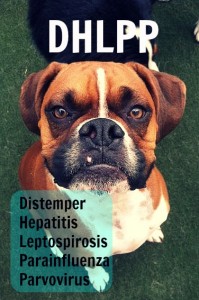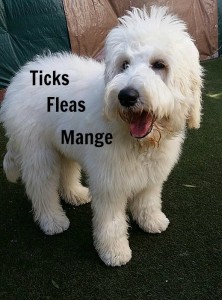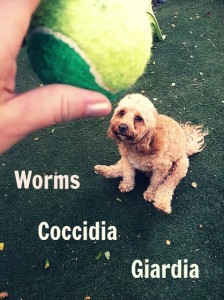The time has come to talk about contagious diseases. It’s not a cute topic, or very fun to write about. To help things along, I’m going to use adorable pictures of WOOF guests for illustration. I truly believe the sheer cuteness of their faces can eradicate these diseases from our lives – or at least make us feel better reading about them.
Usual disclaimer: I’m not a veterinarian and this blog is not a substitute for advice from a medical doctor.

In short, NO – we should not be afraid of dog flu. (Does Mojo look afraid?) I’ll tell you why, but first I want to acknowledge that fear is a natural response when you hear of something “new” that might hurt your dog – and, incidentally, encouraged so that you click on articles. But that’s another topic.
Case in point is the recent rash of stories about a strain of canine flu (H3N2) hitting Illinois and the East Coast and – horror! run! – possibly spreading to us on the West Coast. The fact is, there have been cases reported in many states, including California, and the dog flu is nothing new. This is just a new strain that’s gaining some traction.
(Here is a recent article from a pretty reputable source.)
A flu is a flu is a flu. Yes, they are devious little soldiers whose only mission is to find a host to take over. When they strike out with one host, they mutate to infect new hosts, in new and different ways. We develop vaccines and then they mutate again. They wreak havoc on our bodies but are rarely fatal. So being afraid of it is natural and taking precautions is smart.
But!
But. Before you rush to your vet’s office to get that vaccine or keep your dog away from all other dogs, let’s use the best weapon we have against fear: information. Here are some of the basics about canine flu:
– There are no reports of the canine flu being passed to humans. (Although some reports claim it is being passed from dogs to cats, which would make it a zoonotic disease, one that can be passed cross-species.)
– It has the symptoms you would expect: cough, runny nose, fever. Although not all dogs will exhibit symptoms. (Also, if you’ve never heard a dog cough, it doesn’t sound like what you would expect. It’s a hacking noise like they are trying to expel something.)
– There are vaccines for the two strains of dog flu we’ve identified: H3N2 and H3N8. They work the way all vaccines do by introducing a small, manageable amount of the virus into the system to promote an immune response that will hopefully protect your dog during future exposure.
– Treatment includes supportive care as your dog’s immune system works to fight the virus. Fluid therapy and cough suppressants can help your dog be more comfortable. Antibiotics may be prescribed to battle secondary infections.
– The canine flu “kills” a small percentage of dogs. It is hardest on dogs who have other health issues going on. Pneumonia is the main secondary condition to be worried about.
When I get questions from clients about how bad the latest dog scares are, it’s helpful to humanize the situation. For example, would you be afraid to die if you caught the flu? I’d say most of us would not. Would you be afraid if your grandmother, who has a heart condition and emphysema, got the flu? Yes, you would. So if you are worried about the dog flu, think about how healthy your dog is in general and how their bodies might react to the virus before you decide your course of action.
Since we’re on the subject, let’s run down all the other things your dogs can “catch” from another dog. Since the majority of this blog’s readers are WOOF clients, I know you want to know!
Let’s start with the diseases your dog regularly gets vaccinated against.

Ah, the big one. This is the main combo vaccine your dog gets several times when she’s a puppy, then yearly, then every three years until she dies. Some vets delete the Lepto part; some give the Lepto part solo. We don’t really need to worry about these diseases because the vaccines do a great job halting them in their tracks. So get those vaccines! (If you’ve ever met a dog with Parvo, you would kiss the syringe. What a horrifying condition.) However, if your dog is older your vet may suggest stopping the vaccine regimen because odds are your dog’s antibodies are going to protect her without any more boosters and vaccines are taxing her system.

The big condition with the little name. Rabies is not to be messed with – it’s 100 percent fatal once you start showing symptoms and crosses species like nobody’s business. The virus is spread through the saliva and is the only pet vaccine required by law. (That’s why you need to show proof of rabies when getting a dog license.)
For some regions that don’t have rabies – like Hawaii, for example – you have to go through a quarantine period in addition to a specific vaccine regimen in order to think about bringing your pet into the state. Aloha, Rabies! (And I mean the “goodbye” kind of Aloha here.)

This is the vaccine that is designed to combat the latest strain of canine tracheobronchitis. This is the clinical term for “kennel cough.” But us in the boarding biz do not like this term – we prefer “canine cough” because kennels aren’t the only places that pass around doggie colds. Dog parks, pet stores – anywhere dogs congregate – can be a hotbed for transmission.
There are a couple things to know about canine cough. One is that (like the flu) it is very rarely fatal and only severely affects dogs who have other health issues going on. Dogs can still get it who are current on the vaccine because the virus is constantly mutating. Dogs can be asymptomatic and pass it to other dogs. These are all the reasons why boarding or daycare facilities have limited control over the spread of canine cough.
If you opt for the vaccine (and it’s not optional at WOOF!) it’s given in two forms: intra-nasal and the traditional subcutaneous method. Protection lasts anywhere from 6 months to a year. I advise that people get this vaccine for their dog – even if they don’t go to doggie daycare- because some protection is better than none. Unless your dog is sickly and the introduction of unnecessary vaccines taxes their system – then you should weigh your options and maybe opt to keep your dogs away from other dogs.

Mouth warts! MOUTH warts? These, more accurately called oral papillomas, are small, clustery warts caused by the papilloma virus. They are contagious dog-to-dog but NOT dog-to-human (thank goodness). They are irregular in shape, resembling cauliflower, and typically grow on the lips, inside of the mouth and on the tongue.
They are generally harmless but can be uncomfortable depending on their size and location. In rare cases, they are a precursor to cancer. There is not yet an effective treatment except removing the warts. When we see a case like this at WOOF, we isolate the dog from the other dogs and won’t allow the affected dog back in group until the warts have fallen off or have been removed – whichever happens first.

Oh, this is a good one. I specifically used the laymen’s term for this because I want to make sure I’m addressing something I think is frequently misunderstood. Pink eye’s clinical term is conjunctivitis – it refers to the inflammation of the conjunctiva, the moist membrane that coats the inner surface of the eyelid.
The red inflammation can be caused by many things, only a few cases being contagious from the passing of a virus or bacteria. Many cases are caused by an allergen in the air – pollen, mold, dander – or a pre-existing condition in the eye that somehow becomes exacerbated.
So if your dog has an eye problem, it’s not necessarily something she caught from another dog. Whatever the source, eye issues should be addressed immediately and the good news is there are many treatments at your disposal to help your dog feel more comfortable right away.

Oh boy, this is a toughie. Let’s go hardest to easiest.
Mange is an ugly, devastating skin disease caused by parasitic mites. The dog loses hair and develops really obvious scabs and skin irritation.The contagious part is when the mites jump from one animal to another. Sarcoptic mange is when the mites burrow in the skin and demodectic mange is when they live in the hair follicles. (In humans, a similar mite infestation is called scabies. And humans CAN catch sarcoptic mange from dogs so watch out! Humans can also catch Ringworm from dogs. They’re not actually worms but a bacterial infection. Read more here.)
The treatment is what you’d imagine: isolating the dog, thoroughly cleaning everything the dog came in contact with (especially bedding, where those little mites are building condos), and the dog is repeatedly bathed with a special shampoo (usually sulfurated lime). Vets may also prescribe a drug called Ivermectin. Successful treatment can take one or several months depending on the case.
Fleas have been relatively easy to control with modern products like Advantage and Frontline. However, even these super products have their limits as the fleas quickly adapt and become immune to their formulas. Ask your vet what flea product they recommend and be aware you might have to switch things up once in a while based on your pet’s health and what products the fleas haven’t yet become wise to.
Remember just because you kill the fleas on your dog, there might still be some in the environment. Consult a pest control service or ask your best friend for their favorite home remedy. I’ve heard things ranging from candles in plates full of water to herbal sprays.
One thing I can advise against: do NOT use or trust flea collars. Every vet I’ve worked for has said they do nothing to fight fleas and can actually be dangerous to your dog. Plus, they smell awful and are gross and our dogs deserve nice smelling things on them – or at least bad-smelling things that they choose to put on themselves.
Ticks are the easiest of all to deal with. You don’t have to light a match or get out the tweezers. You simply put your finger on the tick and make a quick circular movement applying moderate pressure until the tick pops out. Flush that sucker. If part of the tick is left in the skin, worry not – the body will expel it naturally as a foreign object. Just keep an eye on it for infection. And yes, Neosporin works just as well on pets as it does on us.
The trick with ticks is finding them. You need to do a thorough tick inspection every time your dog is in a wooded or bushy area. Ticks can transmit diseases if they are attached to your dog long enough. The prevalence of these disease-bearing ticks varies by region. There are tests to determine if your dog has Lyme Disease, and only about 10 percent of dogs who test positive will develop clinical signs. (You need to also be aware of Lyme Disease because it is a truly devastating condition for humans as well.)

Now that we’ve talked about external parasites, let’s talk about the internal ones. And yes, I just shivered writing that.
The most common worms are roundworms, hookworms, whipworms and tapeworms. Tapeworms look like white grains of rice in the stool and come from a dog eating a flea. The other worms come from dogs eating stool or soil infected with that parasite. Hookworms can also enter the body through the skin, usually on the feet.
Worms, though gross to think about, are actually good news because they are very treatable. They are also easily detected by a fecal exam. If your dog is acting sick, many vets will suggest a fecal straight away to rule out worms.
Giardia and Coccidia are the “non-worm” internal parasites frequently found in dogs. If your dog has one of these, the main symptom is diarrhea. And more diarrhea. (Sometimes vomiting from mild nausea.) Some dogs don’t show symptoms at all.
Like other parasites, the primary route of infection is from fecal-oral contamination. This can even happen when a dog eats infected poop and then drinks water and then a new dog gets it from the water. You can imagine all the scenarios. (You imagine them; I don’t want to right now.)
There are good tests to detect these conditions and good treatments. A follow-up test is typically given after the treatments to determine that it is truly gone. At WOOF, as with any other preventable contagious disease, we can’t allow a giardia or coccidia-positive dog to intermingle with other dogs until they are cleared by the vet.
And finally:

Heartworm is a devastating disease that kills dogs and is a monster to treat. Worms are passed from dog to dog by a mosquito. Foot-long worms grow in the heart, lungs and blood vessels and literally suffocate the dog’s organs, disrupting their activities, and possibly killing the dog.
Heartworm disease is more prevalent on the East Coast than the West Coast, but should be tested for and treated if your dog has any outdoor exposure. Heartgard is the most traditional preventative but you can ask your vet for alternatives. Here is a pretty good Heartworm prevalence map.
Heartworm-positive dogs can be treated but it is very intensive and expensive, and in some cases doesn’t work at all. That is why I believe heartworm medication, especially if you live in a high-risk area, is a way better deal than taking your chances.
I may not have covered all the contagious diseases, but this is a pretty comprehensive list of the major ones and the minor ones we encounter most often at WOOF.
As you can see, controlling diseases in the dog population is never an exact science. No facility can guarantee your dog will NEVER catch anything because that’s just not how diseases work. They lie in wait, looking for weaknesses. That weakness may be a vaccine that’s not the right strain, or a dog who is sick but not showing any signs or a water bowl that has giardia spores hiding in it, ready to infect its next host.
The only way to protect your dog fully is to wrap them in bubble wrap and never let them do anything. You may be preserving their life, but really, what kind of life would it be?
I say play on, inform yourself, and make educated decisions that are right for you and your dog! There’s no better feeling than outsmarting a disease. I highly recommend it.

xoxo,
Vickie Jean
